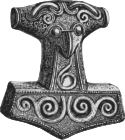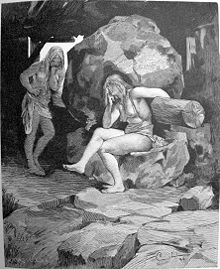- Jötunn
-
"Frost Giant" redirects here. For the music album, see Frost Giant (album).
 The jötnar Fafner and Fasolt seize Freyja in Arthur Rackham's illustration to Richard Wagner's Der Ring des Nibelungen.
The jötnar Fafner and Fasolt seize Freyja in Arthur Rackham's illustration to Richard Wagner's Der Ring des Nibelungen.
A jötunn (anglicized jotunn or jotun;
 /ˈjoʊtən/, /ˈjoʊtʊn/, or /ˈjɔːtʊn/;[1][2] Icelandic: [ˈjøːtʏn]; from Old Norse jǫtunn /ˈjɔtunː/) was a giant in Norse mythology, a member of a race of nature spirits with superhuman strength, described as sometimes standing in opposition to the races of the tribes of the Æsir and Vanir, although they frequently mingle with or intermarry with these. Their otherworldly homeland is Jötunheimr, one of the nine worlds of Norse cosmology, separated from Midgard, the world of humans, by high mountains or dense forests. Other place names are also associated with them, including Niflheimr, Utgarðr and Járnviðr.
/ˈjoʊtən/, /ˈjoʊtʊn/, or /ˈjɔːtʊn/;[1][2] Icelandic: [ˈjøːtʏn]; from Old Norse jǫtunn /ˈjɔtunː/) was a giant in Norse mythology, a member of a race of nature spirits with superhuman strength, described as sometimes standing in opposition to the races of the tribes of the Æsir and Vanir, although they frequently mingle with or intermarry with these. Their otherworldly homeland is Jötunheimr, one of the nine worlds of Norse cosmology, separated from Midgard, the world of humans, by high mountains or dense forests. Other place names are also associated with them, including Niflheimr, Utgarðr and Járnviðr.Contents
Etymology
In Old Norse, the beings were called jǫtnar (singular jǫtunn, the regular reflex of the stem jǫtun- and the nominative singular ending -r), or risar (singular risi), in particular bergrisar ('mountain-risar'), or þursar (singular þurs), in particular hrímþursar ('rime-thurs'). Giantesses could also be known as gýgjar (singular gýgr) or íviðjur (singular íviðja).
Jǫtunn (Proto-Germanic *etunaz) might have the same root as "eat" (Proto-Germanic *etan) and accordingly had the original meaning of "glutton" or "man-eater", possibly in the sense of personifying chaos, the destructive forces of nature.[3] Following the same logic, þurs[4] might be derivative of "thirst" or "blood-thirst." Risi is probably akin to "rise," and so means "towering person" (akin to German Riese, Dutch reus, archaic Swedish rese, giant). The word "jotun" survives in modern Norwegian as giant (though more commonly called trolls), and has evolved into jätte and jætte in modern Swedish and Danish, while in Faroese they are called jatnir [jaʰtnɪɹ]/[jaʰknɪɹ] (Singular: jøtun [jøːtʊn]). In modern Icelandic jötunn has kept its original meaning. In Old English, the cognate to jötunn is eoten, whence modern English ettin.
The Elder Futhark rune ᚦ, called Thurs (from Proto-Germanic *Þurisaz), later evolved into the letter Þ. In Scandinavian folklore, the Norwegian name tusse for a kind of troll or nisse, derives from Old Norse Þurs. Old English also has the cognate þyrs of the same meaning.[5]
Norse jötnar
Origins
The first living being formed in the primeval chaos known as Ginnungagap was a giant of monumental size, called Ymir. When he slept a jötunn son and a jötunn daughter grew from his armpits, and his two feet procreated and gave birth to a son, a monster with six heads. These three beings gave rise to the race of hrímþursar (rime thurs, frost giants), who populated Niflheim, the world of mist, chill and ice. The gods instead claim their origin from a certain Búri. When the giant Ymir subsequently was slain by Odin, Vili and Vé (the grandsons of Búri), his blood (i.e. water) deluged Niflheim and killed all of the jötnar, apart from one known as Bergelmir and his spouse, who then repopulated their kind.
Character of the jötnar
Giantesses Fenja and Menja from the poem Grottasöngr.
Some of the jötnar are attributed with hideous appearances – claws, fangs, and deformed features, apart from a generally hideous size. Some of them may even have many heads, such as Thrivaldi who had nine of them, or an overall non-humanoid shape; so were Jörmungandr and Fenrir, two of the children of Loki.
Yet when jötnar are named and more closely described, they are often given the opposite characteristics. Very old, they carry wisdom from bygone times. It is the jötnar Mímir and Vafþrúðnir Odin seeks out to gain this ancient knowledge. Many of the gods' spouses are giants. Njörðr is married to Skaði, Gerðr becomes the consort of Freyr, Odin gains the love of Gunnlod, and even Thor, the great slayer of their kind, produces a child with Járnsaxa; Magni. As such, they appear as minor gods themselves, which can also be said about the sea giant Ægir, far more connected to the gods than to the other jötnar occupying Jotunheim. None of these fear light, and in comfort their homes do not differ greatly from those of the gods.
Ragnarök and the fire jötnar
Main article: RagnarökA certain class of jötnar are the fire jötnar (Múspellsmegir or eldjötnar), said to reside in Muspelheim, the world of heat and fire, ruled by the fire jötunn Surtr ("the black one"). The main role of the fire jötnar in Norse mythology is to wreak the final destruction of the world by setting fire to the world at the end of Ragnarök, when the jötnar of Jotunheim and the forces of Hel shall launch an attack on the gods, and kill all but a few of them.
List of Jotnar
- Fire Giants
- Frost Giants
- Rock Giants
- Rime Giants
See also
- Rephaim
Notes
- ^ Merriam-Webster's Dictionary
- ^ Random House Unabridged Dictionary
- ^ Norman Cohn, Cosmos, Chaos, and the World to Come: The Ancient Roots of Apocalyptic Faith, 2001, ISBN 0300090889.
- ^ Refer Thurisaz or thorn.
- ^ [1]
References
- Faulkes, Anthony (transl. and ed.) (1987). Edda (Snorri Sturluson). Everyman. ISBN 0-460-87616-3
- Larrington, Carolyne (transl. and ed.) (1996). The Poetic Edda. Oxford World's Classics. ISBN 0-19-283946-2
 This article contains content from the Owl Edition of Nordisk familjebok, a Swedish encyclopedia published between 1904 and 1926, now in the public domain.
This article contains content from the Owl Edition of Nordisk familjebok, a Swedish encyclopedia published between 1904 and 1926, now in the public domain.
Norse paganism Deities,
heroes,
and figuresOthersAsk and Embla · Dís (Norns · Valkyries) · Dwarf · Einherjar · Elves (Light elves · Dark elves) · Fenrir · Hel · Jörmungandr · Jötunn · Sigurd · Völundr · Vættir
Locations Asgard · Bifröst · Fólkvangr · Ginnungagap · Hel · Jötunheimr · Midgard · Múspellsheimr · Niflheim · Valhalla · Vígríðr · Wells (Mímisbrunnr · Hvergelmir · Urðarbrunnr) · YggdrasilEvents Sources Society See also Anglo-Saxon paganism and mythology Gods and divine figures Heroic figures Other beings Locations Sources Origins Society and culture Neopagan revival Categories:- Jötnar
Wikimedia Foundation. 2010.

